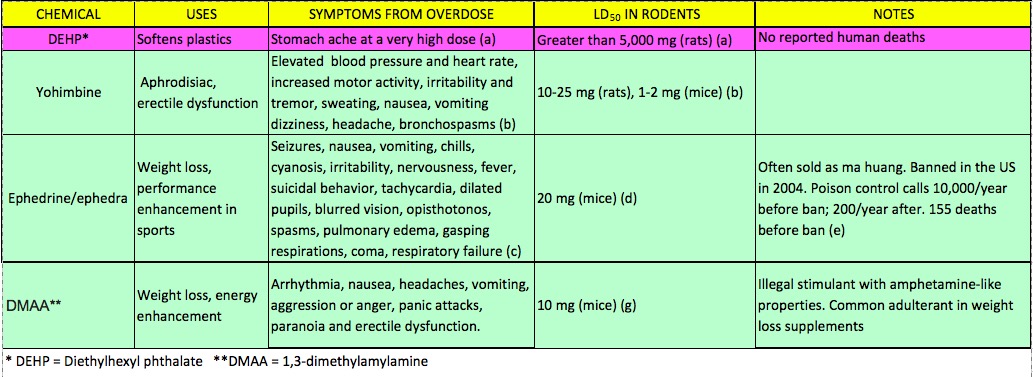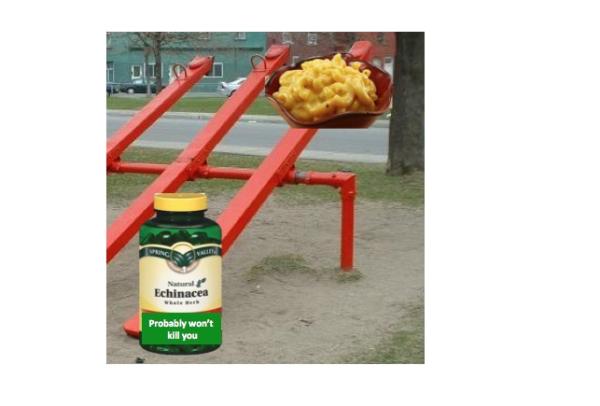It never ceases to amaze me how easily people can be manipulated into worrying about nothing simply because the "nothing" is portrayed as (but really isn't) scary, while at the same time pay no attention to a "something" because it is portrayed as healthy (which is just as wrong). There can hardly be a better example of this logicakl disconnect than the silly July 12th hit piece in the Times (1) about the "horrors" caused by tiny amounts of phthalates in mac and cheese packaging, and yesterday's CNN report about the increase in the number of poison control center calls due to kids ingesting dietary supplements, a topic about which I have written many times (2).
People who are scared out of their minds about their kids being exposed to a tiny amount of long-used, harmless phthalates are being encouraged to write petitions to Kraft to get rid of all traces of them. But at the same time, many of them are blithely using supplements, which can be real poisons, and are leaving them sitting around where their kids can get their hands on them. Which is just what happens.
The CNN report, which is based on a new paper in the Journal of Medical Toxicology, notes that calls to poison control centers involving dietary supplements rose by 50% during the years 2005-2012 and that the majority of these calls involved children. This risk of supplements is obvious, but not the benefit. The products that are being touted as supplements not only don't actually supplement anything but are, in fact, drugs by any definition of the word (3). The "supplement-drugs" which have poisoned kids were primarily weight loss and "energy" products, and yohimbine, all of which can be unsafe for either kids or adults. Because these drugs are often dangerous, some are illegal. The numbers sure support this.
Dietary supplements were responsible for 275,000 calls to poison control centers between 2000-2012, which works out to one every 24 minutes. Calls about phthalates during those 12 years? I'm going to go out on a limb and say zero (4). Perhaps it is time to rethink what we are afraid of and why. I'll start.
Let's take a look at the toxicity of phthalates and three commonly used supplements (5). You may wonder, just like all of us at the Council, what all the fuss in the Times was about and why potentially dangerous drugs are being treated as if they were Pez. You should wonder.
The figure below speaks (screams, really) for itself.

| References | |
| (a) US Consumer Prodoct Safety Comission | |
| (b) NIH | |
| (c) TOXNET | |
| (d) Science Labs MSDSMSDS | |
| (e) Harvard Medical School | |
| (f) HRF.org | |
| (g) TOXNET | |
I chose diethylexyl phthalate (DEHP) because it is has been commonly used, but the story would be more or less the same with any of the dozen or so phthalates that are in use. These "deadly" chemicals are, in fact, so "un-deadly" that just about the only way to kill a rat with them is to have a truck full of DEHP run it over. Feeding it to the rat, even in huge amounts, won't do the job because DEHP is simply a terrible poison. And if you're looking to kill more than rats, it's not so great at killing humans either. If a person eats 10 grams of DEHP (not recommended, but possibly safer than a Chipotle meal) it will give you a stomach ache. (The only way to do this would be to order it from a chemical supplier and spoon it into your mouth—as dumb an idea as you'll ever see.) Five grams won't even give you a stomach ache. There has been an ongoing concern about the use of phthalates in kids' toys, but your kid could chew on every rubber ducky in the universe and not ingest 10 grams of any phthalate (6).
But, the story is quite different with the three "supplements." As shown in the figure, all three can produce a myriad of nasty physiological effects, even at "recommended" doses, and can be lethal at higher doses. This becomes evident when you examine the LD50 values—the dose that kills 50 percent of the animals— in mice or rats. DEHP will probably not kill a rat or mouse at a dose of 5,000 mg, but yohimbine, ephedrine, and DMAA (7) will do so at doses ranging from 1-25 mg. I could not find a single example of an overdose death in humans from DEHP, but all three supplement chemicals have killed people. Good luck if you try.
To sum matters up:
- Thanks to scare tactics, people are terrified of trace amounts of chemicals that are harmless even at very high doses. One can only wonder how many boxes of mac and cheese went flying out of windows after the silly Times article came out.
- Thanks to a very bad law (8) and very good marketing, the enormous supplements industry has managed to convince much of the US that their products will promote good health, correct an imaginary deficiency in your diet, and are safe.
- They are not safe, as evidenced by 275,000 poison control calls over a 12-year period.
- These calls have often been a result of dangerous and/or illegal additives, which turn the supplement into a drug, and an untested drug at that. Without the additives, the supplement will probably do nothing—no weight loss, no extra energy, no erections.
- Yet, phthalates are considered to be "bad" and supplements are "good."
- This is dead wrong.
- This whole thing is nuts.
I wonder what the Times would say about this. Just don't hold your breath.
Notes:
(1) For my response to the Times article, see: NY Times Goes Mac & Cheesy With Science
(2) See: Poorly Regulated 'Herbal Supplements' Could Be Your Worst Nightmare (with Dr. Henry Miller)
(3) The FDA definition of a drug is: "A substance recognized by an official pharmacopeia or formulary. A substance intended for use in the diagnosis, cure, mitigation, treatment, or prevention of disease. A substance (other than food) intended to affect the structure or any function of the body." But as a result of DSHEA, supplements can skirt this definition, even though there is no scientific rationale for this exception. None. If a supplement is being used to lose weight or to give you energy or an erection, it's a damn drug. Period. Regardless of what DSHEA says.
(4) A report of an adult who accidentally swallowed 10 grams of DEHP, one of the common phthalates, noted that the individual suffered "mild gastric disturbances and 'moderate catharsis.”' Doses of five grams produced no effect.
(5) The Journal of Medical Toxicology cites ma huang, yohimbe, homeopathic agents and energy drinks as the most dangerous supplements. This is all kinds of crazy, since homeopathic agents should contain nothing but water if they are really homeopathic. So companies that sell dangerous "homeopathic agents" that actually have something in the bottle are lying and selling dangerous junk. Nice.
(6) All these data are based on acute, single-dose feeding experiments and address only acute toxicity. The long-term effects of chronic consumption of trace quantities of phthalates is a different (and long) story, which is not suitable for this article. But the conclusion is the same: stop worrying.
(7) There are a number of illegal drugs that have been sold as energy enhancers. I chose DMAA because it is commonly used and is now in the news. The former owner of a Fort Meyers-based dietary supplement company that sold weight-loss and ADD pills that contained DMAA just got sentenced to 18-months in prison. Too bad it wasn't longer.
(8) For some "light reading" on DSHEA, see:
Preventing Heart Disease With Vitamin BS (with Dr. David Seres)
DSHEA Allowed 23 Yrs Of Disgraceful Cancer Claims By Supplement Makers




